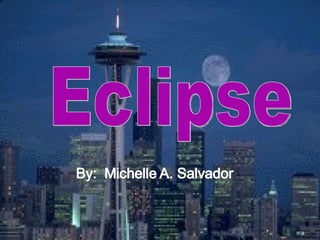
Eclipse
- 1. Eclipse
- 2. Celestial bodies in space such as the moon and Earth cast shadows. They casts shadow because the are opaque bodies. Earth and the moon cast conelike shadows. This occurrence is observed from the Earth as an Eclipse .
- 3. Why Are There Eclipses? Both the moon and the Earth do not produce their own light. They borrow their light from the sun. Being both opaque, they do not allow light to pass through.
- 4. When the moon, the earth, and the sun are in one straight line, shadow may fall on either the moon or the Earth. An eclipse occurs when a celestial body blocks light from reaching another celestial body.
- 6. Lunar Eclipse During the full moon, the Earth is between the sun and the moon. When the sun shines on the side of the Earth, the light does not pass through. The shadow of the Earth is formed. The Earth’s shadow may fall on the face of the moon.
- 7. When the face of the moon is covered with the Earth’s shadow, the moon cannot reflect the sun’s light. It will be dark even during full moon. This is Lunar Eclipse. A lunar eclipse may be partial or total.
- 9. If the moon is in the dark part of Earth’s shadow (umbra), there is a total lunar eclipse . If it is in the light part of the shadow (penumbra) there is a partial lunar eclipse . A total lunar eclipse can last for more than an hour
- 10. Solar Eclipse During the new moon, the moon is between the sun and the Earth. The moon passes over the same place twice a day, one at night one during the day, because the Earth rotate.
- 11. If the moon passes over the Earth as the sun shines on one side of the Earth, the moon blocs the sunlight and a shadow of the moon is formed. This shadow falls on the surface of the Earth. The part of the earth that receives this shadow of the moon will be darkened. The people will experience darkness (like night) even during daytime. This is called solar eclipse.
- 12. Solar Eclipse
- 13. Total Solar Eclipse During a solar eclipse, the moon moves between the sun and the earth. The light from the outer part of the sun’s atmosphere, called the corona, became visible during a total solar eclipse on July 11, 1991, in La Paz, Baja California, Mexico. The moon’s shadow on earth appeared only as a thin band not more than 269 km (167 mi) wide.
- 14. During a solar eclipse, the moon casts shadow of the earth, with a dark region called umbra and the lighter region called penumbra. If the Earth is inside the umbra, Earth experience a total solar eclipse. If the earth is inside the penumbra, it will experience only a partial solar eclipse.
- 16. An annular eclipse occurs when the tip o the umbra does not reach the earth. You can only see a bright ring around the sun, which is called an annulus . This only happens in an eclipse of the sun, never in an eclipse of the moon.
- 18. Why a Total Solar Eclipse Seldom Happens? There are two reasons for this. First, the moon’s orbit is tilted five degrees to Earth’s orbit. Second, the moon is so small that its dark shadow can barely touch the earth’s surface.
- 19. During a total solar eclipse, a small place can be totally dark, like nighttime. The longest may be seven and a half minutes. But this darkness is confined only to a small place, the place where the dark shadow if the moon falls. The other places are bright and sunny.